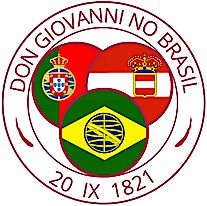
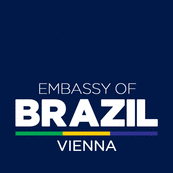
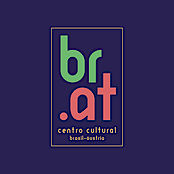
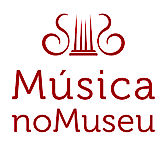


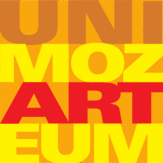







International Conference
Vienna – Don Juan Archiv Wien
Trautsongasse 6, A-1080 Wien
Inauguration Concert at the
Embassy Residence of Brazil
Prinz-Eugenstraße 26, A-1040 Wien
organised by
Don Juan Archiv Wien
Embassy of Brazil in Vienna
Divino Sospiro – Centro de Estudos Musicais Setecentistas de Portugal
Universität Mozarteum Salzburg
Musica Brasilis
Petit Palais Rothschild
Prinz-Eugen-Straße 26
Greetings by H.E. Ambassador Nelson Antonio Tabajara de Oliveira
Fantasia for Solo Flute, Paris 1823
Adapted for Oboe by Harold Emert
Canzonetta for Soprano and Piano, Rio de Janeiro 1816
Adapted for Bassoon and Piano
Les Adieux de Neukomm à ses amis à Rio de Janeiro, for piano, Rio de Janeiro 1821
L’amoureux Fantasia for Piano and Flute, Rio de Janeiro 1819
Adapted for Piano and Oboe
Variations on a Menuet by Jean-Pierre Duport, for Piano, 1789 (KV 573)
Nocturne Trio for Oboe, Bassoon and Piano (originally written for Oboe, Horn and Piano as well as alternatively for Violin, Cello and Piano, Rio de Janeiro 1817)
Harold Emert (Oboe)
Richard Meek (Bassoon)
Aleida Schweitzer-Milewski (Piano)
Silvia Hablitschek (Narrator)
Organized by Centro Cultural Brasil-Áustria and Música no Museu
Organizers:
Marcelo Cardoso Gama (Centro Cultural Brasil-Áustria)
Sergio da Costa e Silva (Música no Museu)
Trautsongasse 6/6
Matthias J. Pernerstorfer (Don Juan Archiv Wien)
H.E. Ambassador Nelson Antonio Tabajara de Oliveira (Embassy of Brazil in Vienna)
H.E. Ambassador Miguel de Almeida e Sousa (Embassy of Portugal in Austria)
H.E. Ambassador Teresa Indjein (Austria Foreign Ministry, Department of International Cultural Affairs)
Rosana Lanzelotte (Musica Brasilis)
Iskrena Yordanova (Divino Sospiro - Centro de Estudos Musicais Setecentistas de Portugal)
Stefan David Hummel (University Mozarteum Salzburg)
Rogério Budasz (University of California, Riverside)
Between Natural and Proper: Refashioning Opera in Brazil (1750s–1830s)
Chair: Rosana Lanzelotte
Fernando Santos Berçot (National Library of Brazil)
Italian Opera and the Birth of Theatre Criticism in Rio de Janeiro (1820–1831)
Rosana De Moraes Marreco Orsini Brescia (Universidade Nova de Lisboa)
The Spanish Libertine and the Opera Houses of 18th and 19th Century Brazil
Chair: Fernando Santos Berçot
Käthe Springer-Dissmann (Redaktion Tagbau Wien)
Archduchess Leopoldine of Austria, first Empress of Brazil. Her childhood and youth in Vienna
Paulo de Assunção (Instituto Histórico e Geográfico Brasileiro; Universidade Nova de Lisboa)
Empress Maria Leopoldina: Political Action and the Art of Reigning
Rosana Lanzelotte (Musica Brasilis)
D. Pedro de Alcântara. The Monarch Composer and His Time
Chair: Francesco Cotticelli
Iskrena Yordanova & Ricardo Bernardes (Divino Sospiro Queluz / CEMSP)
Leopoldina of Austria, Sigismund von Neukomm in Rio de Janeiro and the Viennese Musical Heritage in Portugal and Brazil
Herbert Lindsberger (Universität Mozarteum Salzburg)
Neukomm on Tour
Chair: Hans Ernst Weidinger
Julio Bandeira (Brazilian Historic and Geographic Institute, Rio de Janeiro Historic and Geographic Institute, National Library of Brazil)
The 1817’s Unknown Thomas Ender Sketchbook, an Illustrated Journal of a Biedermeier Artist in Rio
Chair: Matthias J. Pernerstorfer
Francesco Cotticelli (Università degli Studi di Napoli Federico II)
Don Juan towards the Contemporary World. Some Reflections on a Changing Plot
Magnus Tessing Schneider (Stockholm University)
Germanness and Spanishness in Don Giovanni’s Early 19th-Century Performance History
Chair: Iskrena Yordanova
Paologiovanni Maione (Conservatorio di Musica San Pietro a Majella di Napoli)
Mozart tradito: le versioni ottocentesche del Don Giovanni a Napoli
Maria Venuso (Università degli Studi di Napoli Federico II)
Don Giovanni Tenorio by Louis Henry at the San Carlo in Naples (1820)
Chair: Suna Suner
Francesco Milella (University of Cambridge)
Divismo overseas:Manuel García and Don Giovanni in Postcolonial Mexico City
Reinhard Eisendle & Hans Ernst Weidinger (Don Juan Archiv Wien)
Don Giovanni in Rio de Janeiro (1821). Touching a White Map
Fernando Santos Berçot, Ricardo Bernardes, Rogério Budasz, Reinhard Eisendle, Rosana Lanzelotte, Francesco Milella, Hans Ernst Weidinger
Chair: Reinhard Eisendle
Alexandre Guilherme Montes Silva (Universidade de São Paulo)
Brazilian Contemporary Opera. Reflections on the Poetics of the Feminine in Jocy de Oliveira’s Stage Works
Jean Paul Bucchieri (Escola Superior de Teatro e Cinema Centro de Investigação em Artes e Comunicaçã, Lisboa)
2056, como construir o mito de Don Giovanni
PROGRAM Download
On 20 September 1821, Da Ponte’s and Mozart’s Don Giovanni was performed for the first time in Brazil, by the “Companhia italiana” at the Real Theatro de São João in Rio de Janeiro; in those days Rio was the capital of the Kingdom of Brazil then united with the Kingdom of Portugal. That evening, the opera was seen and heard for the very first time beyond Europe – five years before the famous first New York performance of 25 May 1826 at the Park Theatre by the Garcia Opera Troupe, with the involvement of Lorenzo da Ponte, the opera’s poet.
On 20 September 2021, the bicentenary of the Rio performance was celebrated by Don Juan Archiv Wien together with all cooperation partners – Centro Cultural Brasil-Áustria (Vienna), Divino Sospiro Centro de Estudos Musicais Setecentistas de Portugal (Queluz/Lisbon), Universität Mozarteum (Salzburg), Musica Brasilis (Rio de Janeiro) – with a livestream concert featuring the contributions of Brazilian, Portuguese and Austrian musicians.
Currently, Don Juan Archiv & Partners are preparing an international symposium to be realized in Vienna from 29 September to 1 October 2022, with a focus on the cultural-political context of that remarkable event in 1821 as part of a historical constellation connecting Brazil via Portugal with Austria.
Fourteen years prior to the Rio Don Giovanni, on 29 November 1807, the evening before the occupation of Lisbon by Napoleon’s army, the Portuguese Court left for Brazil. On 8 March 1808, Rio de Janeiro became the new capital of the Império Português. This brought about essential changes in the social and cultural infrastructure of the city and in the political framework of the colony.
The city was, for example, enriched with the construction of a new opera house, opened in 1813. Two years later, the colony (a viceroyalty), as a result of the Vienna Congress enactment from 16 December 1815, was raised to the rank of a kingdom, thus putting it on a par with Portugal. Three months after, on 20 March 1816, at the death of Queen Maria I, the united crowns devolved upon her son the Prince Regent, thenceforth King João VI of Portugal, Brazil, and the Algarves.
At that period, the King looked for a bride for his 19-year-old eldest son and successor Dom Pedro de Alcântara, and found her in the second daughter of the Austrian Emperor Francis I, the Archduchess Leopoldina who disembarked in Rio de Janeiro on 5 November 1817. The nuptials were accompanied by an imperial expedition, reputed to be the 19th century’s most remarkable European one to Brazil.
At the time of the Archduchess’ arrival in Rio, the Salzburg-born composer and pianist Sigismund Neukomm was residing there as a member of King João’s Court. A pupil of both the Haydn brothers (Michael in Salzburg, Joseph in Vienna), he became the music teacher of Dom Pedro and Dona Leopoldina.
On 23 April 1821, four years after the Austrian wedding, the Portuguese Court left Brazil. The King installed his son Dom Pedro Prince Regent who with his wife remained in the country. The following five months prior to the premiere of Don Giovanni were politically turbulent, with mutinies and revolts probing the political manoeuvrability of the 23-year-old new Príncipe regente. On 2 September 1822, not even one year after that premiere, the Council of State, convoked and presided over by Dona Leopoldina, enacted the secession of Brazil from Portugal. On 7 September the news reached Dom Pedro who stayed with his entourage on the Ipiranga River near São Paulo where he proclaimed Brazil’s independence with the legendary Grito de Ipiranga, “Independência ou Morte”.
Thus, the first performance of Don Giovanni in Rio de Janeiro can be seen as an exemplary intersection of cultural, diplomatic, and political transfers between the Old and the New World, to be analysed at the Vienna conference in September 2022.
The Portuguese Court’s relocation to Brazil brought an intensified exchange with the cultural scene of Europe, involving the transfer of the Portuguese Court composers and musicians, but also raising the attraction of Rio de Janeiro, now capital, for artists from other European countries. A new theatre house was built (at the Rocio square, actually Praça Tiradentes) in the style of the Teatro São Carlos in Lisbon: The Real Theatro de São João, named after the Prince Regent Dom João and inaugurated on 12 October 1813, the 15th birthday of the Prince Regent’s son, the future Emperor Dom Pedro I. The “composers in residence” for dramatic music were Marcos António Portugal, Bernardo José de Sousa Queirós, and Padre José Maurício Nunes Garcia. On 17 December 1814, Queen Maria’s 80th birthday, in this new house Axur re di Ormus by Da Ponte and Salieri was performed – the first ‘Viennese’ opera outside of Europe.
- In what specific ways and on which occasions has “opera” been installed in the Portuguese colony during the 18th century? What were the European models, and how were they remodelled to specific Brazilian performance practices? Did there already exist a “thoroughly sung” opera in the 18th century? What was the role of music in Brazilian plays, and in which ways did Brazilian composers participate in this process?
- Did the opera practice change during the Court’s presence in Brazil from 1808 to 1821, be it in repertoire, in performance style, or in the recruitment of singers and musicians?
- What was the international ranking of the musicians before they left Europe for an engagement in Brazil? Among them were the singers Carlotta d’Aunay, Teresa Fascioti, Isabella Ricciolini, Marianna Scaramelli, Juan Lopez Estremero, Pompilio Panizza, Michele Vaccani, and Mariano Pablo Rosquellas; the mandolin player Bartolomeo Bortolazzi; and the dancer Luis Lacombe (Scaramelli and Bortolazzi were also engaged by Viennese theatres before their Rio arrival).
- Did the Court want to glorify its transfer to Brazil – f.e. with the myth of Ulissea and O trionfo da America, just to mention two plays with music by José Mauricio Nunes Garcia?
- Did the theatre serve as a public = political space? By what means did the theatre reflect the sensible process of a potential separation from Portugal? Was it mere coincidence that King João’s birthday on 13 March 1822 was celebrated with the musical comedy As tres sultanas (about the domestication of a despotic ruler) and the ballet O desertor frances? What was the political meaning of oriental dramas in the “tropics”, considering that on the day of Dom Pedro’s acclamation as Emperor (12 October 1822) a drama with the title Independencia da Escócia (by Kotzebue?) was given, and on the day of his coronation (1 December 1822) Rossini’s Isabel de Inglaterra?
- How did the three Companies – the Brazilian, the Italian, and the Dancing one – at the Real Theatro São João interact? Did “music” serve as an integrating factor? What does the repertory of plays, operas, and ballets tell us about the time of the Portuguese Court’s presence in Brazil?
- What was the role libretto prints played in the perception of operas? When and where have the first librettos been printed in Brazil? After the arrival of the Portuguese Court in Rio, were libretti edited exclusively for courtly celebrations? What provoked the folhetos de cordel for the audiences of Brazilian theatres?
- How were the Brazilian theatres financed and sustained during the Court’s presence there?
- How was theatre organised after the Declaration of Independence, i.e. during the reign of Dom Pedro I (1822–1831)?
According to the Don Juan Archive’s research, the first production of Da Ponte’s and Mozart’s Don Giovanni beyond Europe was the one premiered in Rio de Janeiro on 20 September 1821. This is a correction of the claim that the opera had been performed at the Park Theatre in New York already on 7 November 1817. On that occasion, not Don Giovanni was given, but The Libertine, a two-act opera by Isaac Pocock, premiered in London, at Covent Garden, on 20 May 1817. This Libertine is a combination of Thomas Shadwell’s tragedy of the same title (London 1675), of the London Don-Juan-Pantomimes of the 1780s, and of Da Ponte’s Don Giovanni. The great success of the latter’s first London stage production (King’s Theatre at the Haymarket, 12 April 1817, in the original Italian language) was the inducement for The Libertine which included twelve of the original twenty-four numbers of Mozart’s Don Giovanni music (arranged by Henry R. Bishop). Here, Don Juan and Donna Elvira have mere speaking parts, while the Commander’s statue doesn’t speak at all. Don Giovanni’s ‘Champagne Aria’, along with his part in the duet “Là ci darem la mano”, is sung by Masetto, and the serenade, as in the Italian versions of the 17th century, is given to Don Octavio. In the Rio production Donna Elvira and the Commendatore were interpreted by singers, and it is highly probable that Pablo Rosquellas, for whose benefit Don Giovanni was presented, sang the title role as he did in Buenos Aires six years later.
Rio de Janeiro was the first city outside Europe to perform Da Ponte’s und Mozart’s Don Giovanni; likewise in Rio, the first Don Juan play beyond Europe was staged during the 1770s. The performance of Don Juan plays in Brazil can be proved also during the Don Giovanni time: on 7 September 1822, on the evening of the Ipiranga day, Dom Pedro visited the São Paulo theatre; acclaimed by the audience, he went on the stage and played a hymn of his own composition (the Hino de Independência which, during his reign as Emperor, became Brazil’s first national anthem) – the evening’s centrepiece, following Dom Pedro’s appearance, was O convidado de pedra.
- Which political processes preceded and accompanied the Rio premiere of Don Giovanni?
- To what extent can we reconstruct the Rio performance of 1821? Are there sources beyond the Diario di Rio de Janeiro? How did the score find its way from Europe to Rio? What can we say about the singers and their contributions to the opera’s roles?
- Is Mariano Pablo Rosquellas a link to European Don Giovanni productions? Is the libretto of Rosquellas’ Buenos Aires production from 1827 a credible source for reconstructing the Rio performance? How is the Buenos Aires libretto related to the opera’s libretto prints of the early 19th century, especially the Italian ones?
- Are the texts of the Don Juan plays in Brazil identical with the Portuguese Comédia nova intitulada O Convidado de Pedra ou Don João Tenório o Dissoluto written in the 1760s in Lisbon by an unknown author, passed down by diverse manuscript copies submitted to the Portuguese censorship, and first published in Lisbon in 1785? The print is an adaption of Molière’s Dom Juan ou Le festin de pierre with a happy ending (the renewed union between D. João and D. Elvira his “espoza”). Where has this play been performed in Portugal and in Brazil during the 18th and 19th centuries? Do we know about other Don Juan versions in Portuguese language?
- In English versions, and after North America (Philadelphia 1792, pantomime), Don Juan came to Africa (Cape Town 1811, pantomime), Asia (Calcutta 1821, Byron`s Don Juan), and Australia (Sidney 1833, musical extravaganza). Can we follow and reconstruct these further transfers of the subject?
Throughout the Portuguese Court’s presence in Brazil had been in use, apart from the sites for popular music, two types of public music locations: the theatres, featuring operas, ballets, scenic music, during the intermissions also excerpts from music of other operas; and the churches, offering sacral music, influenced by opera style. Hitherto, there were no concert halls as established in many European cities since the 18th century – nonetheless, concert music was heard in various social spaces.
- What do we know about the concerts given in Brazil in the early 19th century – from chamber music to the performance of orchestral works?
- How was the concert music written in Brazil distributed? Who produced, who purchased the scores? Who were the musicians interpreting it?
- What have been the concert venues – from the Court to salons of the Portuguese and Brazilian gentry?
- What do we know about the reception of this music?
In 1816, having travelled from Paris to Rio with a French embassy delegation, Neukomm was recommended by his host Count Barca, one former Portuguese envoy in Paris, to King João who recruited the composer “sans portefeuille”. In return, Neukomm gave lessons in French and music to Dom Pedro, then also to Dona Leopoldina. During his stay in Rio, he wrote chamber music (occasionally using motifs from Brazilian dances), orchestral pieces, and masses (one commissioned by Dona Leopoldina for her father the Emperor in Vienna). With a Libera me he completed Mozart’s Requiem for its first performance in Rio in 1819, whereof he published a brief account in the Leipziger Allgemeine Musik Zeitung (July 1820).
In 1820, the first Brazilian book on music appeared: Noticia historica da vida e das obras de José Haydn … por Joaquim Le Breton … traduzida em portuguez por hum amador (Rio, Impressão Regia; original Paris 1810), enriched by Neukomm’s corrections and additions, and dedicated to him.
The composer returned to Paris in April 1821 where he published a collection of twenty songs (modinhas) by Joaquim Manoel da Câmara. Thus, the “Salzbourgeois” Neukomm may be called a true transmitter of knowledge between two continents, in both directions.
- Exemplified by the Rio Requiem and the Haydn book, Neukomm is considered a central promoter of Haydn’s and Mozart’s music in Brazil. Where, since when, and on what occasions the music of these composers has been played in Brazil? What happened before Neukomm’s arrival in 1816, reminding the Rio concert by the singer Carlotta d’Aunay in 1809, where at least two Mozart overtures have been performed by grand orchestra? Which influences of Haydn and Mozart can be analyzed in the compositions of José Mauricio Nunes Garcia?
- What was Neukomm’s influence on music composed in Brazil? Is it legitimate to call him “the Father of Brazilian Chamber music”?
- How did Neukomm modify his style in sacral music in light of the locally prevailing taste? In what ways does his mass written in Rio for the Austrian Emperor differ from the sacral music conceived for the Portuguese Court?
- Did his Rio pieces for orchestra contribute to the local theatrical culture?
- What exactly was his input to the Brazilian Haydn book of 1820?
- How is Neukomm’s role in the history of Brazilian music seen by Latin American Musicology?
was composed of Austrian, Bavarian and Tuscan scholars: among others, Johann Christian Mikan, Johann Natterer, Johann Baptist Emanuel Pohl, and Heinrich Wilhelm Schott, from the Austrian side; Carl Friedrich Philipp von Martius, and Johann Baptist von Spix, sent by the King of Bavaria; and Giuseppe Radi sent by order of the Grand Duke of Tuscany. With them were the Austrian painters Thomas Ender und Johann Buchberger.
Two Austrian frigates, Austria and Augusta, with the majority of expedition members on board had sailed from Trieste on 9 April 1817; the Austria landed in Rio on 14 June, the Augusta, due to ship damages, on 4 November, the day before Archduchess Leopoldina’s debarkation. In 1818, the first to return to Europe was the expedition’s head, Mikan together with both the painters; in 1821 followed the botanists Pohl and Schott – the zoologist Natterer remained until 1835.
More than 100,000 objects (minerals, plants, taxidermy, ethnographica) have been sent to Vienna where, from 1821 to 1836, a good three quarters of them came to exhibition in the Brasilianum (directed by Pohl), the first European museum entirely devoted to a non-European country; still today, parts of the collection are on display (Natural History Museum; World Museum); the more than 700 designs and aquarelles by Thomas Ender are kept in the Akademie für Bildende Kunst.
- What were the scientific, economic, political, and cultural aims of this expedition? How was it organised? What had been the artists’ role?
- What were the results? In which ways they were communicated? How was the interaction with the scientific community in Europe?
- How was the Vienna Brasilianum organised and structured, and how it was received by the public?
On 13 May 1817, the wedding by proxy between Archduchess Leopoldina and Dom Pedro took place in the Augustinian Church in Vienna. Archduke Charles, who had emerged victorious of the battle at Aspern and Eßling (1809) against Napoleon, appeared for the bridegroom. Three months after – on 15 August 1817, the Feast of the Assumption – the Archduchess set sail from Livorno on a Portuguese squadron (the frigates D. João VI and São Sebastião).
- What was Leopoldina’s educational background and progress in Vienna?
- Which political calculations were involved in the marriage between Dom Pedro and the Archduchess?
- In which public forms, notably theatrical and musical ones, was this union celebrated in Austria, in Portugal and in Brazil?
- What do we know about Leopoldina’s impact on the cultural life of Brazil?
- How has her political influence been understood in the course of historiography, and how can it be characterized according to current approaches?
- Dom Pedro, who shared his wife’s love of music, is known as the composer of the Hino de Independência (1822). He wrote many other works, among them a Marcha imperial, an Abertura para a Independência do Brasil, the Hino da Maçonaria (1822), the Hino da Carta (1834) which served as the Portuguese anthem from 1834 to 1910, a Credo, various Te Deum, and a Mass.
- To which compositional models did he refer?
- Which role did his works play in his political staging?
- What do we know about the reception of his works in Europe?
* * *
CALL FOR PAPERS (Download)
The conference proceedings will be published by HOLLITZER Verlag, Vienna, and the book will be presented by Don Juan Archiv Wien as the first volume of the new series Brasiliensia.
For further information on the Don-Juan-in-Rio-Project, please see the following booklet
Sigismund Neukomm in Brazil. A Concert Commemorating the Bicentenary of the First Performance of Don Giovanni out of Europe on 20 September 1821 (Vienna: Hollitzer 2021)